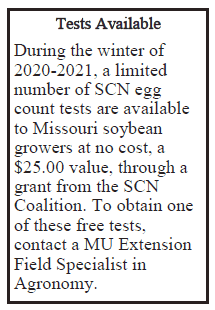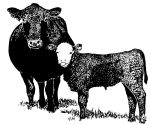

To send a message to an author, click on the author's name at the end of the article.
This Month in Ag Connection | Ag Connection - Other Issues Online
Soybean cyst nematode (SCN) is one of the most devastating pests of soybeans in the United States, reducing yield and costing the soybean industry an estimated $1.3 billion annually. More than 80 percent of crop fields in Missouri are infected with SCN. Plants may appear normal yet suffer up to 30 percent yield loss when roots are infected with SCN. Symptoms may not appear until infestation levels are very high, and include yellowing of leaves, plant stunting, and plant death under extreme conditions. It can be difficult to determine by observation if these symptoms are the result of SCN or another cause such as nutrient deficiencies, herbicide injury or drought stress.
After the nematodes hatch the juveniles penetrate the root and begin feeding. This drastically affects plant growth by limiting the root's ability to take up nutrients and water. Soybean cyst nematode can also affect the number of nitrogen-fixing nodules a soybean plant develops.
Once a field is infested with SCN it cannot be eradicated, it must be managed. Using varieties which have a SCN resistance trait can help offset yield loss. Unfortunately, nearly all varieties use the PI 88788 source of resistance. Over time, SCN has become tolerant of the resistance and can reproduce on the roots of SCN resistant varieties. This means it is important to manage SCN through other means.

If a host crop is not available the nematodes cannot reproduce. Crop rotation with a non-host crop is one of the best ways to manage SCN. Some non-host or poor-host crops include: alfalfa, barley, canola, red and white clovers, corn, cotton, forage grasses, oats, rye, radish, sorghum and wheat. Weed control is important in SCN infested fields since some weeds, like henbit and deadnettle, serve as a host.
Soybean cyst nematode is spread through the movement of infested soil. To reduce the potential of transferring SCN on equipment, work in fields which are not infested before fields which are infested. Clean soil from equipment when moving from one field to another, especially if SCN is known to be present.
Testing which can be done any time of year, can help producers determine the level of infestation and provide strategies for management. Egg counts are usually highest immediately after harvest of a soybean crop which is an ideal time for testing. Divide fields into 10-acre sections to obtain the most representative estimation of infestation since nematodes are not evenly distributed throughout a field. Take the sample directly in the soybean row rather than between rows since nematodes grow on the roots. Using a clean plastic bucket, collect 15 to 20 soil cores using a soil probe, eight inches deep, randomly throughout the field walking in a zig zag pattern. Mix the samples well and place about one pint of soil in a plastic bag. Label the bags with the grower's name and field identification. Samples should be stored in a cool place, out of direct sunlight until they are submitted to the SCN Diagnostic Laboratory. More information can be found at www.scndiagnostics.com
Source: Valerie Tate, Agronomy Field Specialist
This Month in Ag Connection | Ag Connection - Other Issues Online

The success of calving season starts long before the arrival of the first-born calf. The USDA's National Animal Health Monitoring System (NAHMS) conducted a beef cow-calf study in 2017 and 2018. The study involved producers in 24 states (including Missouri) representing more than 70% of beef cows in the United States. Results from the questionnaire found nearly all calves (97.7%) were born alive. The percentages of calves born alive to heifers and to cows were similar across herd sizes, while a higher percentage of calves were born alive to cows than to heifers. Since 55.6% of calves were born in February, March or April, for most producers, calving is right around the corner and now is the time to prepare.
Body Condition
Producers should walk through the spring calving herd and body condition score (BCS) animals. Beef cattle are scored from 1 (thin, emaciated) to 9 (fat, obese). Mature cows need a body condition score of 5, while first-calf heifers need to be at a score of 6 going into calving. If cows are not in calving condition, a supplement with higher quality feed is needed so animals can gain condition prior to calving. In most situations, if 20% of cows have BCS of 3 or 4 and the other 80% have a BCS of 5 or greater, then separate and feed accordingly. Feeding cows and heifers prior to calving does not cause calving difficulties. Increasing BCS from 4 to 6 does not increase dystocia rates but will increase rebreeding rates from 50 to 96% (in a 65-day breeding season). Producers should also make sure plenty of feed is readily accessible near the calving area.

Calving Equipment and Supplies
Calving equipment and supplies need to be obtained and gathered into one location prior to the start of the season. The calving barn and equipment should be clean and in good working condition. A calving toolbox or bucket should include a clean bucket, disinfectant, liquid soap, lubricant, obstetric (OB) gloves, OB chains, OB handles, paper towels or towels, and calf ear tags and tagger. A calf jack is beneficial if it is used properly. Producers should also make sure medications and colostrum are on hand.
Colostrum Replacement vs. Colostrum Supplement
A calf with inadequate colostrum intake is ten times more likely to get sick or die than a calf that gets enough colostrum. Colostrum is the first milk and contains antibodies, energy, and immunological cells and compounds. The immune system response of calves is competent at birth; however, it has no antibodies to fight infection. Colostrum must be ingested by newborn calves within six hours of birth to acquire satisfactory passive immunity. Hand feeding colostrum may be necessary for calves who experienced difficult births or have not nursed within the first four hours. Like the product names indicate, colostrum replacers are used to "replace" colostrum, meaning they are used instead of colostrum; while supplements are used to "supplement" or in conjunction with maternal colostrum intake.

Parturition and Calving Techniques
A knowledge of normal parturition, or the birthing process, is imperative in order to know what is abnormal. Producers should be familiar with the stages of labor, and length of each stage, the difference between cows and heifers, the different calf presentations, and how to assist if needed. Producers should not rely on internet searches to answer questions when time is of the essence to get a live calf on the ground. Reviewing when and how to assist a cow having a difficult birth and knowing when to call a veterinarian for assistance is a must for a successful calving season. Normal delivery should be completed in one to two hours after the water sac appears. In normal presentations, the front feet should appear after the water bag and the hoof will be down. If a first-calf-heifer has not calved within one to one and a half hours after the water sac, it might indicate help is needed.
A successful calving season begins at breeding with the selection of the bull(s) and continues with proper nutrition and management during gestation and especially three-six months prior to the start of calving. Now is the time to prepare mentally and physically for the arrival of baby calves.
For more information contact the local MU Extension livestock specialist.
Source: Heather Conrow, Livestock Field Specialist
This Month in Ag Connection | Ag Connection - Other Issues Online
Ornamentals
Houseplants
Miscellaneous
All Month
Source: Missouri Botanical Garden
Source: Jennifer Schutter, Horticulture Specialist
This Month in Ag Connection | Ag Connection - Other Issues Online
MU Extension has released many new and updated publications. The publications are all available online at the website https://extension.missouri.edu/publications, then use the search box on the left to search either by title or by the publication number. Publications are also available at most County Extension Centers. Following are some of the more popular publications recently released and updated:
2021 Budgets:
Publishing Information
Ag Connection is published monthly for Northeast and Central areas of Missouri producers and is supported by the University of Missouri Extension, the Missouri Agricultural Experiment Station, and the MU College of Agriculture, Food and Natural Resources. Managing Editor: Mary Sobba.